
Welcome to the Tesla Memorial Society of New York Website
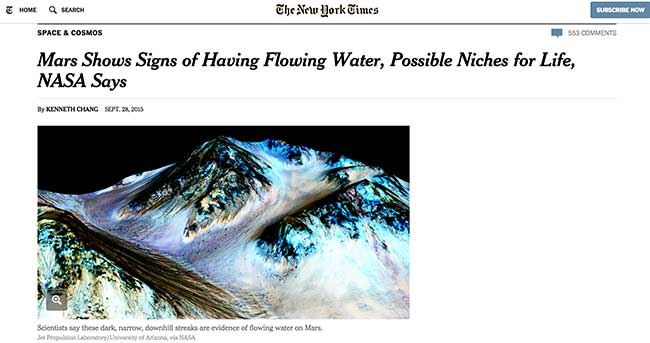
Above: Mars Shows Signs of Having Flowing Water, Possible Niches for Life, NASA Says. NY Times Article Sept. 28, 2015

Mars Exploration Rover Mission - January 3, 2004
Nikola Tesla and the Exploration of Cosmos - The landing of remote control robots on Mars used technology first developed by Nikola Tesla.
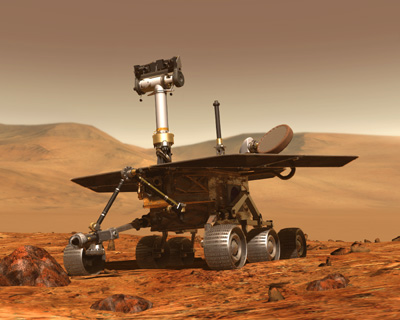
NASA released a 3-D panoramic view of the Spirit rover's Mars landing site on Monday, January 3, 2004.
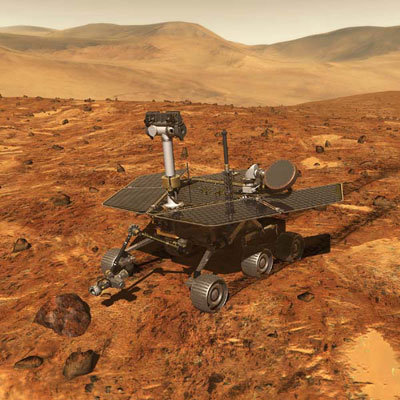
Mars Exploration Rover Mission
Landing Site on Mars of the Rover Spirit on January 3, 2004
The Mars Exploration Rover mission is part of a scientific campaign aimed at seeking traces of life on Mars. Water is a key element in that search for life, since on Earth, life is found virtually everywhere there is liquid water.
Major Missions to Mars (1964- Present)
| 1964 | U.S. launches Mariner 3, which fails after liftoff. |
| 1964 | U.S. launches Mariner 4. First successful Mars fly-by in July 1965. The craft returns the first pictures of the Martian surface. |
| 1964 | Soviets launch Zond 2. Mars fly-by. Contact lost in May 1965. |
| 1969 | U.S. launches Mariner 6 and 7. The two spacecraft fly by Mars in July and August 1969 and send back images and data. |
| 1971 | Soviets launch Mars 2. Orbiter and lander reach Mars in November 1971. Lander crashes but orbiter sends back images and data. |
| 1971 | U.S. launches Mariner 8, which fails during liftoff. |
| 1971 | U.S. launches Mariner 9. Orbiter reaches Mars in November 1971, provides global mapping of Martian surface and studies atmosphere. |
| 1973 | Soviets launch Mars 5. Orbiter reaches Mars in February 1974 and collects data. |
| 1975 | U.S. launches Viking 1 and Viking 2. The two orbiter/lander sets reach Mars in 1976. Orbiters image Martian surface. Landers send back images and take surface samples. |
| 1992 | U.S. launches Mars Observer. Contact lost with orbiter in August 1993, three days before scheduled insertion into Martian orbit. |
| 1996 | U.S. launches Mars Global Surveyor. Orbiter reaches Mars in September 1997 and maps the planet. Still in operation. |
| 1996 | Russians launch Mars 96, which fails after launch and falls back into Earth's atmosphere. |
| 1996 | U.S. launches Mars Pathfinder. Lander and rover arrive on Mars in July 1997, in the most-watched space event ever. Lander sends back thousands of images, and Sojourner rover roams the surface, sending back 550 images. |
| 1998 | Japan launches Nozomi. Orbiter suffers glitch in December 1998, forcing circuitous course correction. Mission fails in 2003. |
| 1998 | U.S. launches Mars Climate Orbiter. Spacecraft destroyed while entering Martian orbit in September 1999. |
| 1999 | U.S. launches Mars Polar Lander. Contact lost with lander during descent in December 1999. Two microprobes "hitchhiking" on lander also fail. |
| 2001 | U.S. launches Mars Odyssey. Orbiter reaches Mars in October 2001 to detect water and shallow buried ice and study the environment. It can also act as a communications relay for future Mars landers. |
| 2003 | European Space Agency launches Mars Express. Orbiter arrives December 2003, contact lost with Beagle lander. |
| 2003 | U.S. launches Mars Expedition Rovers. Spirit rover lands on Mars in January 2004, Opportunity due to follow later in month. |
NIKOLA
TESLA

Tesla Sculpture by the famous sculptor Ivan Mestrovic at Rudjer Boskovic Institute in Zagreb, Croatia
AND
THE EXPLORATION OF COSMOS

This is a collection of many of the best images from NASA's planetary exploration program. The collection has been extracted from the interactive program "Welcome to the Planets" which was distributed on the Planetary Data System Educational CD-ROM Version 1.5 in December 1995.
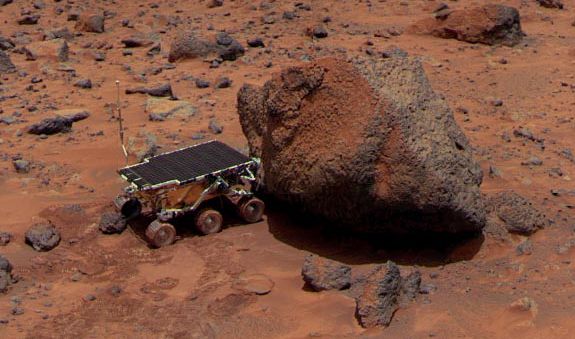
Remotely controlled exploration of the
cosmos began 100 years ago when Nikola Tesla
demonstrated the invention of the robot in New York City.
In 1898 he filed and was granted a patent which described radio
remote control for use in guided vehicles.
Space exploration developed from this first building block.
Tesla publicly demonstrated his first working model of a robot
guided by radio waves. This
device was unveiled to many astonished viewers at the Electrical
Exposition held at Madison Square Garden in May 1898.
This was front page news in America at that time.
It was the first time that the radio waves were used to guide a
movement of a robot-eleven years before Marconi was awarded the Nobel
Prize for the discovery of radio in 1909.
This historic moment at Madison Square Garden in New York City in
1898 showed what marvels could be achieved by using radio waves.
It was the beginning of robots and robotics, radio guided
missiles and remote control.
The radio communications and the
computer guided spaceships from mission control centers are based on
Tesla’s principal of radio remote control for use in guided vehicles.
Nikola Tesla built a laboratory in
Colorado Springs, Colorado, in 1899, to experiment with high frequency
electricity and other phenomena.
In that laboratory he received and recorded on his sensitive
instruments, cosmic radio waves. He announced that he received extraterrestrial radio signals.
The scientific community in 1899 did not believe him, because
knowledge of cosmic radio signals did not exist at that time.
But for decades now, observatory
laboratories all over the world, have been registering cosmic
radio waves
emitted from hydroxyl molecules of interstellar gas clouds and the
envelopes of Red Giant Stars.
Those faint radio waves with high
penetrating potential have frequencies between 1610.6 - 1613.8 Mega
Hertz. They are emitted
from every cosmic material with temperatures above absolute zero (minus
459.67 degrees Fahrenheit).
Tesla’s historic announcement of the
existence of extraterrestrial radio signals in 1899 was met by the
scientific community at that time with resistance and disbelief. But it
was not the first time in history.
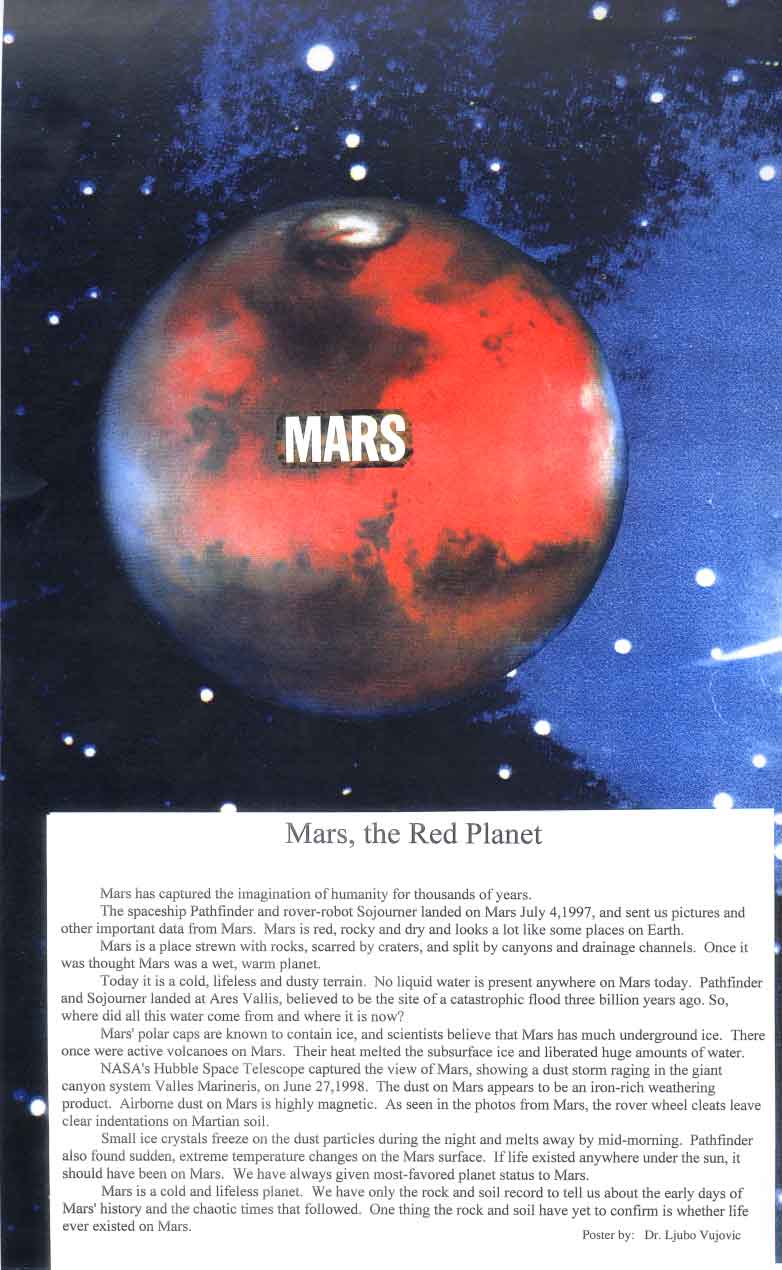
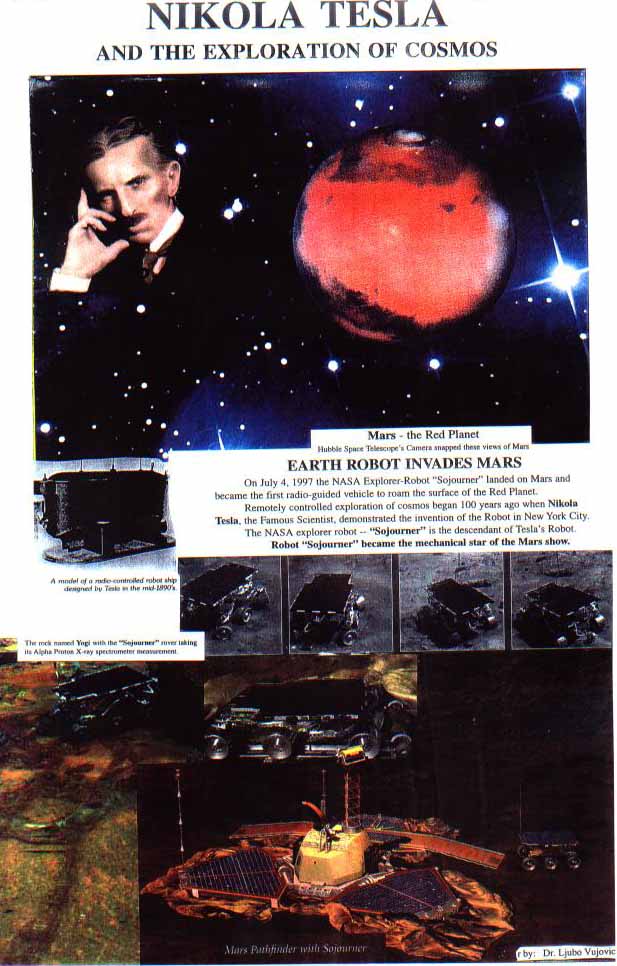
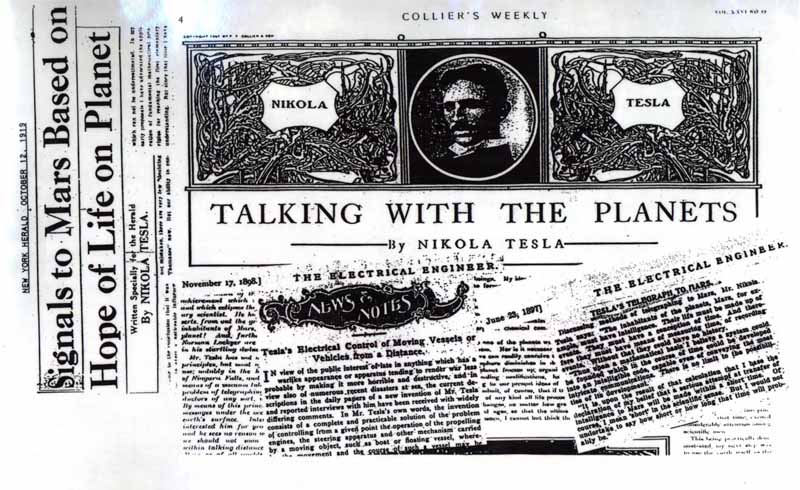
Nikola Tesla : Father of Radio Astronomy
Nikola Tesla Father of Radio and Robotics